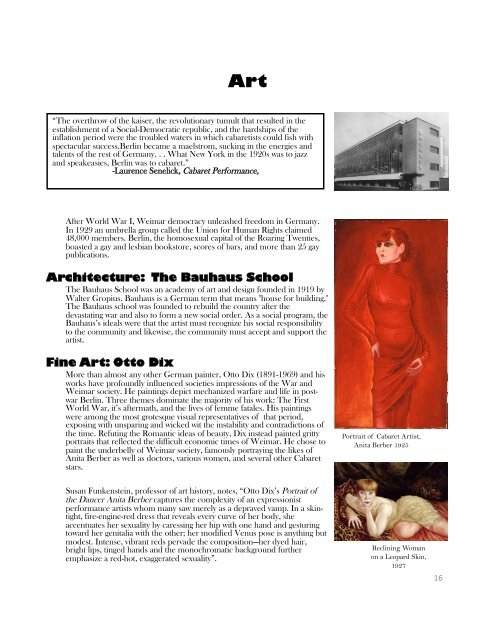You also want an ePaper? Increase the reach of your titles
YUMPU automatically turns print PDFs into web optimized ePapers that Google loves.
Art<br />
“The overthrow of the kaiser, the revolutionary tumult that resulted in the<br />
establishment of a Social-Democratic republic, and the hardships of the<br />
inflation period were the troubled waters in which cabaretists could fish with<br />
spectacular success.Berlin became a maelstrom, sucking in the energies and<br />
talents of the rest of Germany. . . What New York in the 1920s was to jazz<br />
and speakeasies, Berlin was to cabaret.”<br />
-Laurence Senelick, <strong>Cabaret</strong> Performance,<br />
After World War I, Weimar democracy unleashed freedom in Germany.<br />
In 1929 an umbrella group called the Union for Human Rights claimed<br />
48,000 members. Berlin, the homosexual capital of the Roaring Twenties,<br />
boasted a gay and lesbian bookstore, scores of bars, and more than 25 gay<br />
publications.<br />
Architecture: The Bauhaus School<br />
The Bauhaus School was an academy of art and design founded in 1919 by<br />
Walter Gropius. Bauhaus is a German term that means "house for building."<br />
The Bauhaus school was founded to rebuild the country after the<br />
devastating war and also to form a new social order. As a social program, the<br />
Bauhaus’s ideals were that the artist must recognize his social responsibility<br />
to the community and likewise, the community must accept and support the<br />
artist.<br />
Fine Art: Otto Dix<br />
More than almost any other German painter, Otto Dix (1891-1969) and his<br />
works have profoundly influenced societies impressions of the War and<br />
Weimar society. He paintings depict mechanized warfare and life in postwar<br />
Berlin. Three themes dominate the majority of his work: The First<br />
World War, it’s aftermath, and the lives of femme fatales. His paintings<br />
were among the most grotesque visual representatives of that period,<br />
exposing with unsparing and wicked wit the instability and contradictions of<br />
the time. Refuting the Romantic ideas of beauty, Dix instead painted gritty<br />
portraits that reflected the difficult economic times of Weimar. He chose to<br />
paint the underbelly of Weimar society, famously portraying the likes of<br />
Anita Berber as well as doctors, various women, and several other <strong>Cabaret</strong><br />
stars.<br />
Susan Funkenstein, professor of art history, notes, “Otto Dix’s Portrait of<br />
the Dancer Anita Berber captures the complexity of an expressionist<br />
performance artists whom many saw merely as a depraved vamp. In a skintight,<br />
fire-engine-red dress that reveals every curve of her body, she<br />
accentuates her sexuality by caressing her hip with one hand and gesturing<br />
toward her genitalia with the other; her modified Venus pose is anything but<br />
modest. Intense, vibrant reds pervade the composition—her dyed hair,<br />
bright lips, tinged hands and the monochromatic background further<br />
emphasize a red-hot, exaggerated sexuality”.<br />
Portrait of <strong>Cabaret</strong> Artist,<br />
Anita Berber 1925<br />
Reclining Woman<br />
on a Leopard Skin,<br />
1927<br />
16



